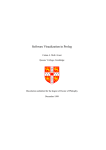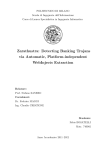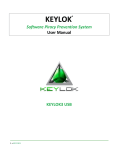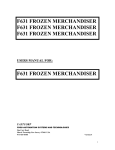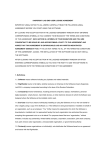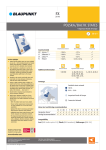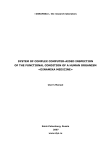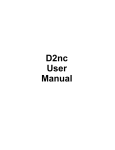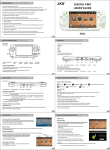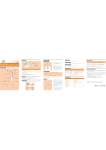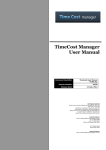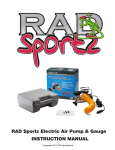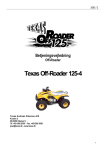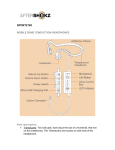Download File
Transcript
5
Structured
programming
If you can't solve a problem, then there is an easier problem you can solve: find it.
George Polya, mathematician
Overview
In the previous two units we have seen how to set up algorithms and how to convert them into
programs. Some of the computer tasks we have to face though may not be straight forward
enough to solve with a simple algorithm or program.
In this unit we will look at a more formal way of going about structuring a solution to complex
programming tasks. Before we do that however we will investigate some of the more useful
ways of handling data.
In this unit we will look at:
arrays
sorting
records
string handling
file handling
malware
the software development cycle
structured programming.
Arrays
In the programs and pseudocode we have seen previously we have worked with individual
variables. To enter three values we have written steps such as:
first =18
second = 34
third = 12
© Kevin Savage 2011 – Licensed to St Mary's Catholic College for use in 2012
Leading Technology
136
But what would happen if we wished to enter twenty values, or fifty, or say we were writing a
program to sort 5 000 scores into order? Obviously it is going to be impractical to have a
separate variable name for each of 5 000 pieces of data. The answer is to use arrays.
An array is a series of memory spaces with the same name, similar to sub-scripted variable
names you might use in Maths or Physics such as x1, x2, x3. We distinguish each element of the
array by the number index that follows it. For example: score(1), score(2), score(3), score(4) is
an array called score that can hold four different values.
Array input and output
To enter a value into an array we use an assignment statement. Written in pseudocode they
would look like:
year(1) = 2005
year(2) = 2006
year(3) = 2007
Output is similar:
write year(1), year(2), year(3)
Simple input and output statements are fine for just a few elements in an array, but to save
writing the same input or output statements over and over we can use counted do or for loops
such as the following:
do j = 1 to 50
prompt for year(j)
get year(j)
enddo
This would loop 50 times, each time getting the user to enter a value that would be stored in
year(1), year(2), etc., up to year(50).
Output could be done similarly:
do j = 1 to 50
write year(j)
enddo
In both cases the loop counter j becomes the index value of the array variable each time the
loop iterates.
It is traditional in programming to use loop counters with the letter names of j, k, l, and so on,
when working with arrays. These counter variables are almost always an ordinal (counting)
type such as integer (1, 2, 3, ....) or char (‘a’, ‘b’, ‘c’,...).
As a further example, say we wished to record test scores for each of 25 students. To do this we
could use the following algorithm in pseudocode to load the array:
do j = 1 to 25
prompt for score(j)
get score(j)
enddo
We can now do various operations with this array such as get an average:
© Kevin Savage 2011 – Licensed to St Mary's Catholic College for use in 2012
Structured programming
137
total = 0
do k = 1 to 25
total = total + score(k)
enddo
average = total/25
write “The average mark for the test is ”, average
or we could find the highest and lowest scores:
max = 0
min = 1000
do l = 1 to 25
if score(l) > max then
max = score(l)
endif
if score(l) < min then
min = score(l)
endif
enddo
write “The highest score is ”, max, “ and the lowest score is ”, min
In this latter algorithm each element in the array is compared with the two starter values of 0
and 1 000. On the first run through of the loop score(1) will be both the highest (>0) and lowest
(<1 000) score and so its value will be stored in max and min. After this, in turn, each other
element in the array is compared to the current values in max and min, with max and min being
updated as new high or low scores come up.
Multidimensional arrays
Arrays are not limited to one dimension but can be two (or more) dimensions. A 2D array has
cells similar to the (x, y) coordinates of a graph. These are useful to store data that can be
represented in table form such as the following:
Maths
English
Science
...
12
23
11
...
7
9
12
...
18
19
13
...
:
To store the marks for 20 students for each of 5 tests we would use nested loops:
do j = 1 to 20
do k = 1 to 5
prompt for mark
get mark(j, k)
enddo
enddo
© Kevin Savage 2011 – Licensed to St Mary's Catholic College for use in 2012
Leading Technology
138
Each time the outer loop ran it would cause the inner loop to iterate five times. This would
store mark(1, 1), mark(1, 2), mark(1, 3), and so on, up to mark(20, 5).
We are not limited to two dimensions. If we wish we can have arrays with three or more parts
to each element. Later we will look at specialised arrays called records that can be used to store
more complex data.
Declaring arrays
In most 3GLs before an array can be used in a program it must be declared, the form of
declaration depending on the language to be used.
The declaration identifies the name of the variable, if it is one or multi-dimensional, the type of
variable it involves, and may indicate the range of values the array can hold.
e.g.
C, C++:
int score[25];
int mark[20][5];
Pascal:
score : array[1..25] of integer;
mark : array[1..20, 1..5] of integer;
Java:
int[ ] score;
int[ ] [ ] mark;
Visual Basic:
Dim Score(1 To 25) As Integer
Dim Mark(1 To 20, 1 To 5) As Integer
In some languages, such as PHP, there is no requirement to declare arrays. The first entry into
the array sets up its structure.
e.g.
$score = Array("65");
$mark = Array(Array("6", "A"));
Any further additions to the array are then just added as needed.
As you do more and more programming you will find that using arrays is a very efficient way
of handling multiple values, as we shall see in the next section on sorting.
Activity 5.1 – Collections
1.
We can have arrays of any type of variable (integer, string, char, etc.).
Write the declaration to be used for each of the following in the 3GL of your choice:
a an array to hold the ages of 15 people
b an array to hold 10 colours
c an array to hold the cost in dollars and cents of 1000 items
d an array to hold 200 addresses
e an array for 30 people’s gender (M/F)
f
a 2D array to store 5 event names with up to 8 students entered for each event.
© Kevin Savage 2011 – Licensed to St Mary's Catholic College for use in 2012
Structured programming
2.
139
Suppose an array has the following elements holding the values indicated:
Element:
time(1)
time(2)
time(3)
time(4)
time(5)
Value:
15
20
12
23
18
What is held in answer as a result of each of the following:
a answer := time(3);
b answer := time(1+4);
c number = 2
answer = time(number)
3.
d
answer = time(2) + time(3)
e
answer = time(4) * time(1)
What values will be loaded into the following arrays (record your answer as demonstrated
in Q2 above):
a do j = 1 to 5
number(j) = j * 2
enddo
b
do k = 1 to 6
cell(k) = k * k
enddo
c
count = 1
do l = 1 to 8
count = count * 2
place(l) = count
enddo
d
do j = 1 to 4
do k = 1 to 4
write j, “ times ”, k, “ is ”, j * k
enddo
enddo
4.
Write a program to enter ten numbers into an array.
The program must then pick the largest and the smallest number, and calculate the average
of the numbers.
5.
Prepare a program that will record the cricket scores of the Bunyip Wanderers. The
program will use an array to store the scores of the 11 cricketers in the team.
The scores will be entered by the user into the array, totalled, and an average calculated.
The program will display the total score, the team average, and also indicate the highest
and lowest score of the team.
Include effective internal documentation.
© Kevin Savage 2011 – Licensed to St Mary's Catholic College for use in 2012
Leading Technology
140
Bubble sort
In order to explore how arrays can be used we will look at the bubble sort.
Computers handle huge volumes of data. When humans come to look through this data we need
it arranged in some way so that we can find what we are looking for. Often we require the
computer to put the data into alphabetical order, or to organise numbers in order with the
largest first.
To reorder the data by computer we use sorting algorithms. There are many of these because it
is such an important part of computing, but for now we will only look at one.
A bubble sort involves moving down a list and comparing each pair of values. If necessary the
values are swapped. The process returns to the beginning of the list again and again until all of
the numbers are in the correct order. The larger numbers rise to the top of the list like bubbles
in water. This method is boring and repetitive for humans but (you guessed it) effective for
computers.
Here is the bubble sort algorithm (not in pseudocode):
repeat until list is in order
if at end of list then
return to beginning
else
compare next two values
if second larger then
swap values
Let’s look at a bubble sort in action on the following set of values, 17 23 14 28 15
The list is not in order and we are not at the end so compare 17 and 23
the 23 is larger so swap them
23 17 14 28 15
compare 17 and 14; 14 is not larger so we leave them
23 17 14 28 15
compare 14 and 28; the 28 is larger so swap them
23 17 28 14 15
compare 14 and 15; the 15 is larger so swap them
23 17 28 15 14
We have now made one run through of the list. At this stage it is still not in order so we start a
second run through.
Compare the first two values:
17 is smaller than 23 so leave them and continue
23 17 28 15 14
28 is larger than the 17 so swap them
23 28 17 15 14
the 17 and 15 are in correct order
23 28 17 15 14
as are the 15 and 14
23 28 17 15 14
The list is still not in order so we start a third run through:
23 is smaller than 28 so swap them and continue
23 and 17, 17 and 15 and 15 and 14 are in order.
28 23 17 15 14
28 23 17 15 14
The list is now in descending order of size.
© Kevin Savage 2011 – Licensed to St Mary's Catholic College for use in 2012
Structured programming
141
Note how values like 28 “bubble” up closer to the top of the list during each run through. This
same algorithm will work as well on 10 000 numbers, or on other data such as names.
Bubble sort algorithms
The only effective way to code a bubble sort algorithm is to use an array to store the values.
This makes it easy to compare pairs of values and, if necessary, swap them over.
The values to be sorted can be input, and the sorted values can be output as shown in the last
section. To input, and later output, 10 values we can use the following:
do j = 1 to 10
prompt for value
get value(j)
enddo
do l = 1 to 10
write value(l)
enddo
The swapping of values is performed by the following algorithm:
do k = 1 to 9
if value(k) < value(k+1) then
temp = value(k)
value(k) = value(k+1)
value(k+1) = temp
endif
enddo
Temp is a temporary or holding variable. It stores the first value while the second overwrites it.
It is then used to overwrite the second.
At this stage we can input the unsorted numbers, we can swap values over, and we can output
the sorted list. The next step is to go through the list repeatedly until it is in order. The simple
way to do this is to run it nine or ten times so that all pairs of numbers are compared. There is
however a better, more efficient way.
What we need to have is some way of recording if a swap has occurred. If on a run through of
the list there has been no swap made then the list must be in order, and there is no need to keep
looping. To do this we are going to use a boolean variable (true/false) that will act as a flag.
This will be set to false, and will only be made true if a swap occurs. If after a run through the
flag stays false then there has been no swap made and we can stop. We will call the boolean
cont (for continue):
cont = true
while cont = true
cont = false
do k = 1 to 9
if value(k) < value(k+1) then
temp = value(k)
value(k) = value(k+1)
value(k+1) = temp
cont = true
endif
enddo
endwhile
© Kevin Savage 2011 – Licensed to St Mary's Catholic College for use in 2012
Leading Technology
142
The while loop will only iterate as long as cont is true. As soon as the loop begins cont is made
false, and it will only be made true if any swap is made. When there are no more swaps the
while loop finishes and the program moves on to display the list in order.
(Why is cont made true before the while loop starts?)
Records
So far we have seen how arrays can store this data, but generally arrays are limited to a single
data type of integer, or string, or some other type.
Many 3GLs have a more powerful data structure known as a record type. A record is like a
multi-dimensional variable, but one in which different types can be stored under one label.
Usually the record type is declared separately, for example in Pascal the following declaration
to record student information:
name = record
firstName : string[12];
surname : string[20];
idNumb : integer;
average : real;
end;
This creates a record type called name that has four fields, the first name, surname, identity
number and subject average for a student. Note that the different parts of the record are of
different variable types (string, integer, real).
Once the record type has been made then an array of the record can be declared; again in
Pascal:
var student : array[1..50] of name;
This array will hold up to 50 sets of information, all of which have the structure identified in
name above.
Individual elements of the record are accessed through a dot notation such as:
student[j].firstName
or
student[j].average
Records are loaded and displayed the same way as normal arrays.
Activity 5.2 – Getting sorted
1.
Line up 10 unordered playing cards.
Follow the steps of the bubble sort
algorithm to rearrange the cards in
order of size.
2.
a
b
c
d
Convert the bubble sort algorithm above into pseudocode.
From your pseudocode prepare a program in a 3GL to sort 10 numbers into order.
Test and run it to check it works for a range of input values.
If your 3GL has the facility to watch or trace values set it up to observe the values in
the array as you step through the program.
Adjust your program so that it can work with any number of input values.
© Kevin Savage 2011 – Licensed to St Mary's Catholic College for use in 2012
Structured programming
143
3.
The bubble sort algorithm is little used nowadays.
a Find out why the bubble sort is not used any more.
b Identify alternative sorting algorithms in use.
c Choose one of these and prepare a program to run it.
4.
Prepare a record declaration in a 3GL of your choice to store information about a CD
collection.
The record is to have fields for title, artist, year, and number of tracks.
String handling
Most of the algorithms and programs we have investigated so far have involved calculations
with numbers. The majority of 3GLs however also have a range of string or char handling
functions that can work with or manipulate text.
Text is composed of a list or string of characters. For example the following string:
39 Middleford Rd, Maleny
holds 24 characters. The numbers 3 and 9, the spaces, and the comma all count as characters.
These characters are usually recorded in memory using the ASCII code.
It is usual to enclose strings in quotes, i.e. “ ” or ‘ ’, depending on the language. These indicate
clearly the beginning and end of the string, especially if there are leading or trailing spaces.
Text is loaded into a string with an assignment statement and output as normal.
address = “39 Middleford Rd, Maleny”
write “The address is ”, address
The output statement above has two strings. The one in quotes is called a literal, while the
second is stored in the variable address.
The principle string handling functions available include the following
search – look through text to find specific characters, or the position within the text of
specified characters
copy – reproduce some or all of a set of characters in text; a smaller string extracted
from a larger one is called a substring
insert or append – add specific characters into text, or add them at either the
beginning or end
replace - change specific characters in text with other characters
concatenate – join two pieces of text into one
delete or trim – remove specific characters from text, or remove them from either the
beginning or end
compare – check if one piece of text is identical to another, or if its length is the same,
or more or less than another
order – place strings in alphabetical (or other) sequence
count or length – find the number of characters in text
convert or replace – change some or all of the text into a different form, e.g. lower to
upper case
© Kevin Savage 2011 – Licensed to St Mary's Catholic College for use in 2012
Leading Technology
144
encryption or decryption – converting the text into, or from, a more secure form
Most programming languages store text as an array in memory, but as long as the text is
declared as a string or char we can handle it like an ordinary variable.
Activity 5.3 – Stringing along
1.
Use the following strings to answer the questions below:
first = ‘nevertheless’
second = ‘fortunately’
third = ‘Now is the time’
a
b
c
d
e
f
g
How many characters in second?
How many characters in third?
What 3 character substring is extracted from first starting at character 6?
What 4 character substring is extracted from first starting at character 2?
Insert ‘not ’ into third starting at character 8.
Delete 2 characters from second starting at character 10.
Convert first to uppercase.
2.
Working with the examples above use string handling functions in a 3GL of your choice
to:
a Find the how many characters are in first.
b Find the how many characters are in second.
c Extract the word ate from second.
d Insert the word only into third between the third and fourth words.
e Delete the third word from third.
f
Change second to read “fortune”.
g Join second to the end of third.
3.
Prepare a program to get the user to enter a person’s first name, then their middle initial,
and then surname. After this use concatenation to join the three into one string. Be careful
to include spaces.
4.
Place the following words in ASCII order, “smallest” first:
cat
5.
catch
can
candle
call
Cat
cane
candy
case
Car
Look at the following pseudocode:
if grade = "junior" then
rate = 15.5
else
rate = 18.75
endif
a
b
Explain what the algorithm does.
Where do you think it could be used?
© Kevin Savage 2011 – Licensed to St Mary's Catholic College for use in 2012
Structured programming
6.
145
A palindrome is a word or phrase that reads the same forwards as backwards. Examples
include madam, Glenelg, Madam in Eden I’m Adam, and one supposedly attributed to
Napoleon, Able was I ere I saw Elba.
The following algorithm will detect if a text string is a palindrome or not:
flag = true
prompt for sample
get sample
count = length(sample)
do j = 1 to (count/2)
start = copy(sample, j, 1)
finish = copy(sample, count – j + 1, 1)
if start < > finish then
flag = false
endif
enddo
if flag = false then
write "This is not a palindrome"
else
write "This is a palindrome"
endif
The length function finds out how many characters there are in the sample while the copy
function will find extract a substring 1 character long from sample starting at the position
indicated by the middle parameter.
By working its way in from either end the algorithm finds if pairs of letters are the same. If
any are not then flag is set to false. This works with both even and odd length strings
(why?).
a Explain how the algorithm works.
b Code the algorithm in a 3GL of your choice.
7.
Prepare a program that counts the number of words in an input text sentence. Do this by
counting how many spaces there are and adding 1 if there is a full stop at the end.
8.
Write a program that will encode a message the user enters.
You may use any code you wish, but the Caesar cipher is one possible method. In this each
character in the message is replaced by a letter say 16 further on in the alphabet.
A B C D E F G H I J K L M N O P Q R S T U V W X Y Z
Q R S T U VW X YZ A B C D E F G H I J K L M N O P
Extend the program so that a message that has been encoded by the program, can be
decoded by the program.
© Kevin Savage 2011 – Licensed to St Mary's Catholic College for use in 2012
Leading Technology
146
File handling
So far we have been limited to the data that can exist in the computer’s memory. When the
computer is turned off the data is lost. To save things more permanently it is necessary to save
the data to disc.
There are three classes of disc file:
sequential or text files for simple read / write operations to get sections of text onto
and off from a disc
random or typed files to work with the user defined record type structures we
investigated above
binary or untyped files that are similar to typed files but with less structure so that the
programmer has more control over precisely how data is written to, and read from
disc.
In each case there is some way of indicating where the file begins and ends on the disc so that it
can be told apart from other data on the disc.
To read data from disc most 3GLs have an eof (end of file) function that can be used with a
while construct. Steps within the while loop will continue until an end of file marker is read.
The following algorithm uses the pseudocode keyword read to indicate data is read from disc
into the variables indicated.
read ID, name, result
while not eof
case of result
1 to 30 : grade = “E”
31 to 50 : grade = “D”
51 to 65 : grade = “C”
66 to 80 : grade = “B”
81 to 100 : grade = “A”
endcase
write ID, name, result, grade
read ID, name, result
endwhile
Three values are read from disc into the variables ID, name and result. The while loop then
runs until the eof marker is detected. Each time it iterates a value is assigned to grade in the
case statement, the values in the variables are output to screen, and then the next three values
are read from disc.
Depending on the 3GL used it may also be necessary to open a file before reading from it, close
it after use, and reset it if using it again.
Activity 5.4 – Disc crazy
1.
Sportz-Craz have a variety of items in stock (cricket bats, netballs, trampolines, etc.). Each
item has an ID code and a cost price (e.g. Argus Cricket Bat 1876 $87.50).
Plan, write and run a program to save onto disc a least five pieces of equipment in a
sequential file. Call the file sportz.dat.
© Kevin Savage 2011 – Licensed to St Mary's Catholic College for use in 2012
Structured programming
2.
147
Once we have the data on disc we can now access it to determine some information about
it. Use the following algorithms to prepare procedures to query the data in sportz.dat (use a
separate subroutine for each):
a Stock count
open Sportz
count = 0
while not eof (Sportz)
read item, code, cost
count = count + 1
endwhile
stock = count/3
write stock, “ items in stock”
close Sportz
b
Value of stock
open Sportz
total = 0
while not eof (Sportz)
read item, code, cost
total = total + cost
endwhile
write “The total value of stock is $”, total
close Sportz
c
Cheapest item in stock
reset Sportz
min = 1000
while not eof (Sportz)
read item, code, cost
if cost < min then
min = cost
endif
endwhile
write “The cheapest item in stock costs $”, min
close Sportz
3.
a
b
c
d
e
Create a file called speeding.dat to record information about fines registered by a
police speed camera. The file will contain information such as date, vehicle
registration number, speed, and fine owing. Populate the file with at least six sets of
information.
Develop a subroutine that can query the file by prompting the user to enter the vehicle
registration number and display all data in that record.
Add another subroutine that will allow the user to enter a date and will then display
all speeding offences for that day and a total of the fines owing on that date.
Add a subroutine to update the file by adding more records to it. (Read all data from
disc into a record array. Add to the array, and then write the extended array to disc.)
Add a fourth subroutine that will delete a record when a fine is paid.
© Kevin Savage 2011 – Licensed to St Mary's Catholic College for use in 2012
Leading Technology
148
SEI 5 – Malware
Not everyone who writes a computer program does it for ethical reasons. There are those who
use their programming skills to develop a category of programs that are collectively known as
malicious software, or malware. Malware is any program designed to alter the way a computer
or information system works without the owner’s knowledge or consent.
For many years the computer virus was the only form of malware. While there are many other
variants of harmful code nowadays, the generic term of virus is often used (incorrectly) to label
them all.
Forms of malware
The original form of malware was the computer virus. These are infected programs that act as
carriers similar to humans infected with a biological virus. Viruses copy themselves from
computer to computer either over networks or through portable media such as flash drives or
external HDDs.
The virus is a program that relies on the host computer to execute its code. When activated the
virus delivers a payload of some kind. This payload may be as benign as displaying a message,
or as harmful as deleting or altering files. A specialised form of virus is a computer worm. A
worm usually consists of some form of script that is spread from computer to computer. It
differs from a true virus in that it spreads across a network or the internet, and not through
infected media such as discs.
A rootkit is malware that allows an outside user access to a computer without the owner of the
computer being aware of it. This access can then be used to control the computer or to run
keyloggers to gather personal details, passwords, credit card numbers, or other financial
information. Similar to a rootkit is a backdoor, code that allows unauthorised users to bypass
the normal authentication process to a computer or system.
Spyware is a program designed to gather information about users or alter the actions of the
computer it is on. Spyware is installed secretly and attempts to remain hidden so that users are
not aware it is there. The installation is carried out by stealth either by piggybacking on the
installation of some other software, or by tricking the user into installing it by pretending it
does something else. When in place the spyware can collect personal information, monitor user
actions, redirect web browsing, or even install additional malware such as a rootkit. A
specialised form of spyware is adware – software that is designed to monitor user preferences
and then download and display advertisements targeted at that user.
Trojans or Trojan horses are a category of malware. These are programs that masquerade as
something else. One example is a supposedly helpful program that the user downloads, that in
reality installs spyware or adware. Another is an email attachment that rather than playing a
video or performing a service carries out an unwelcome function in the system. There are also
some pop-up windows in browsers that act as Trojans when clicked. As a general rule never
open an email attachment, click on a pop-up ad, or run any executable program that you are not
positive is safe.
A botnet is a collection of computers that have been compromised into running programs the
owners did not authorise. This may be as a result of actions of viruses, Trojans, spyware, or the
installation of a rootkit. When such compromised computers are used remotely they are called
© Kevin Savage 2011 – Licensed to St Mary's Catholic College for use in 2012
Structured programming
149
zombie computers; the person who initiates the botnet is known as a bot herder or bot master.
Zombies can be used to send spam or to take part in distributed denial-of-service attacks. The
advantage to the bot master is that not only is he or she using the collective power of many
computers, but they are remote from the offending machines and so cannot be directly linked to
the offence.
Protection from malware
There are probably four classes of people who author malware:
those who write malware in response to the intellectual challenge involved, to see if
they can do it, or as a prank; many are show-offs who want to brag about their skill or
to demonstrate their ingenuity at discovering a security loophole
vandals whose aim is to create as much disruption as possible, taking delight in
knowing they cannot be caught; their actions may be motivated by feelings of
powerlessness, a desire for revenge, or simply the thrill of destruction
those who aim to trick people into releasing information or carrying out activities they
otherwise would not do; these enjoy the feeling of being able to manipulate others;
this is a process known as social engineering
those who seek financial gain through spyware, adware or using remote access to
steal money or commit fraud; here the incentive is for profit.
Whatever the motivation malware writers have little or no regard for the consequences of their
actions. Some malware has caused billions of dollars of damage, others have wasted years of
work.
With the difficulty of detecting the origin of malware it is often impossible to apprehend and to
prosecute the writer. Unfortunately it is relatively easy to develop malware with authoring
programs available for download, and groups who cooperate and challenge each other to
develop new strains.
To avoid the damage that a virus can cause users have to be both prudent and careful. The
following strategies can be used to protect data:
use anti-malware products such as virus scanners, spyware detectors and firewalls to
protect the computer; these work by carefully monitoring the operations of the
computer, if they detect an aberration they notify the user and, if directed, remove the
malware
avoid questionable applications where the originator is not known or trustworthy
be extra careful in the use of portable media such as flash drives or external HDDs
do not run executable email attachments or click on pop-ups without being very sure
of their provenance
since most malware operates in the Windows environment the use of a secure or nonWindows operating system such as Linux is very effective
make regular backups of data in case of infection or data loss.
Unfortunately new malware strains are being developed all the time in an escalating battle with
anti-malware companies. Most of these companies maintain a web site with up-to-date
information on malware and from where up to date information can be obtained.
© Kevin Savage 2011 – Licensed to St Mary's Catholic College for use in 2012
Leading Technology
150
Activity 5.5 – Viruses
1.
a
b
c
What is malware?
Pick one of Trojan, zombie, or rootkit and explain why it is called that.
Find an example of where malware has caused damage, and briefly describe what
happened and the effects the incident had.
2.
a
b
What is a drive-by download?
What forms of malware fit this category?
3.
a
b
What is a keylogger?
What might be some of the malicious purposes of installing a keylogger on a
computer or system?
What forms of malware might install a keylogger on your computer?
c
4.
a
b
c
What is spam? Why is it used?
What is a denial-of-service (DoS) attack? What might be the motivations in carrying
out a DoS attack?
How might malware be involved in setting up remote spam servers or carrying out a
DoS attack?
5.
Describe a good defensive strategy towards malware that you can take with your own
home computer.
6.
The news media often gives much prominence to the reporting of virus outbreaks.
a Why does the media tend to feature these stories?
b What is the image of viruses that the media tends to portray to the general public?
c Suggest the potential effects of this form of portrayal.
d There are many urban myths and spoofs that involve viruses. Find out and report on
one virus myth or spoof and discuss its effect on users generally.
7.
a
b
c
What is meant by the term “social engineering”?
Why is a user more likely to open an email attachment when it apparently comes from
someone they know? In your answer explain why such email viruses are able to
spread so rapidly.
Find out what crimeware is. How is it distinct from spyware or adware? What social
engineering aspects does crimeware utilise?
8.
There is often an irrational fear of viruses based on limited knowledge. Sometimes viruses
are blamed when there has only been a program fault. Why are people so ready to accept
the presence of a virus or other malware in their computer?
9.
Visit the web sites of anti-malware software companies and investigate the range of
viruses and other malware around.
Pick one and report on it.
© Kevin Savage 2011 – Licensed to St Mary's Catholic College for use in 2012
Structured programming
151
Problem solving revisited
There are many different ways people have described systematic problem solving methods but
the simplest and most elegant was developed by the Hungarian mathematician George Polya.
His method is:
1.
Know what the problem is.
2.
Plan a solution.
3.
Try out the solution.
4.
See how good the solution is.
We do this all of the time without realising it – let’s look at a problem to
see how:
Problem: I’m hungry
Step 1 – Know the problem
how hungry am I? (am I Big Mac hungry or just Snickers-bar
hungry?)
how much money do I have?
where can I go to get un-hungry?
George Polya
Step 2 – Plan a solution
will I suffer in silence (not likely!)
I’m really only peckish so I’ll get a Snickers bar
can I do some grovelling near my mates (no chance)
I’ve got $2.50 so I have enough money
I think I will head off to the shop
Step 3 – Try out the solution
go to shop and buy Snickers bar
eat it (yum!)
Step 4 – See how good the solution is
not bad
I’ve not got much money left now, but I’m not so hungry
I’ll probably do this the next time I’m peckish
As you can see the four steps are effective.
Software Development Cycle
While Polya’s problem solving process is effective for small problems it is not detailed enough
for complex tasks such as a programming project. His method has therefore been expanded into
what is known as the Software Development Cycle (SDC).
Shortly we will look at the SDC in action, but for now we will look at each of its parts in detail.
© Kevin Savage 2011 – Licensed to St Mary's Catholic College for use in 2012
Leading Technology
152
Define
The first step is to identify the problem to be solved.
We define the task to make sure we are very clear what we are about to do. This step is often
left out, but not without wide reaching consequences. If we do not know the task we are about
to complete, we will not even begin to know where to start. Added to this we could easily
produce a beautiful solution, and then find it is of no use because it does not complete this task,
but rather a similar one that we thought we were solving.
The Software Development Cycle
At this stage we should also not only decide what has to be done, but answer the question: Who
will use this program? The level of expertise of the end user will strongly influence the user
interface we create.
The definition can consist of an aim for the program, a general problem description, a rationale
for development, and a list of assumptions and boundaries.
Specify
The specification is a coherent conceptualisation (a clear mental picture) of what the program
will do, without saying how this will be achieved. In the specification phase we do not look at
how we will solve the problem, but rather find out where we will be when it is solved. Just
what do we need to arrive at, at the end, to solve this problem?
The specification will involve a detailed description of how we expect the program will
operate. To begin to accomplish this it is a good idea to state our objectives, list what we have
been given, and what output the program will produce.
It is also important at the specification stage to again think of the end users of our program. We
must consider how the running program will appear to the user and how they could be helped if
© Kevin Savage 2011 – Licensed to St Mary's Catholic College for use in 2012
Structured programming
153
in trouble. Making a program that works is important, but making a program that is useable is
even more important.
If you have trouble developing the specification then cycle back to the definition phase as that
has probably not been done properly and you do not really understand what you have to do.
Design
The design phase is where we map the specification onto a process. This means that now that
we are clear what we have to do, we start to think about how we will do it.
There are many possible ways of representing the solution. These include flow charts,
Structured Development Charts, Nassi-Schneiderman diagrams, and pseudocode. You should
select the method that suits you and the problem best.
In the design phase we must also be very aware of the HCI implications and make the program
user friendly. It should be designed to be easy and pleasant to use, and to have help available
where needed. Sketches of possible screen layouts will help with this.
If you are having trouble with the design phase it may be necessary to cycle back to the
previous stage and ensure your specification is complete. (For example in the hungry problem,
if we had not specified what sort of hungry, we might have sat down to a big meal when a
Snickers bar would have been enough.)
Implement
Implementation is where we put our design into place – we convert our plan into a computer
program or programs.
The design should be flexible enough so that this could be done in any 3GL.
Test
Throughout the implementation phase, and when it is completed the program must be tested.
A program that does not work is useless. A program that appears to work but has errors in it is
even worse (why?). Good programmers thoroughly test each program to ensure it is error free.
It is also important to make the program user-proof by preventing the user from getting into
situations she or he cannot handle, or from entering impossible values.
To see if the program works we firstly try it with simple values to see if it gives predictable
results. If all is right we then use a larger range of values to see if it still works. Eventually we
try to “trick” the program to determine if it really is user-proof. This is called alpha testing.
For larger more complex programs, programmers use a set of test data, a wide range of values
that will check as many possible variations on the program as possible. They will also get
outsiders to test the application to ensure it really is user friendly and user-proof (beta testing).
Evaluate
Evaluation is the carrying out of an appraisal of what has been done. It involves both ongoing
evaluation and a formal evaluation at the end.
Ongoing evaluation has been in progress throughout the software development cycle. We make
judgements as we go on aspects such as task requirements, screen presentation, user interface,
algorithm design, implementation methods, and so on. At each stage we should also look at
© Kevin Savage 2011 – Licensed to St Mary's Catholic College for use in 2012
Leading Technology
154
what we have done and decide if we are still on track. If not it is necessary to repeat the
previous stage (cycle back).
Formal evaluation takes place when the project is finished. It involves looking back to see if the
solution fits the specification. Have you done what you set out to do, and is it reliable, easy to
use and free from errors? If you were a part of a team, how well did the group perform? You
can also check to see if you have solved the problem the best possible way, to see if you have
learnt anything you can use next time, or just to give yourself a pat on the back.
In some cases it is worth getting others to use your program so that you can get outside
feedback, especially from someone who is not as familiar with it as you are.
Document
Documentation is an ongoing activity throughout the software development cycle. At each
stage you will need to record your progress.
In small programs documentation can be minimal, but in full-sized applications documentation
is vital. Computer code can be extremely difficult to understand. It is part of your job as a
programmer to ensure that other people (and even yourself) can understand what you have done
in a program.
To do this you will be expected to make the program code itself understandable (internal
documentation) and give some other written idea of what the program does (external
documentation).
Internal documentation includes using meaningful identifiers for variables and subroutines, by
spacing the program out with white space and indentation, and the use of effective comments.
External documentation will consist of your definition, program specification, the algorithms
and pseudocode/flowcharts/NS diagrams, and the evaluation. It may also include a user manual
or on-line help.
Using the SDC
At first the SDC might appear cumbersome and time consuming, but it is a tried and tested
method that is used widely in the software industry.
It is important to realise that the early steps in the software development cycle are the most
important. The more time spent on the design stages, the less time there needs to be spent on
the implementation, testing and possible redesign of the solution. It has been found in the
computer industry that it is very expensive to alter a program that has been written if there are
fundamental design errors, errors that may not show up until the program is in place and has
been running for some time.
An indication of the importance given to the early stages of the SDC are the relative wages of
software developers. Programmers, the people who actually cut (write) the code are the lowest
paid. The systems analysts who design the specifications for the programs earn higher wages as
their job is far more important in the long run.
The real value in programming is in the specification and design stages of the software
development cycle. By using the SDC you will not only be using the method employed in the
industry as the most effective, you will also be giving yourself every help in developing your
own programs.
© Kevin Savage 2011 – Licensed to St Mary's Catholic College for use in 2012
Structured programming
155
Activity 5.6 – SDC
1.
a
b
c
List the steps involved in the software development cycle?
Why is the SDC used in the software industry to prepare applications?
Why are the definition and specification steps so important?
2.
Identify which step of the SDC each of the following might be:
Going on a date (not in order)
I will ask dad for the car, pick up Sam, go to the movies, and return home
I think I will go with someone else next time
go on date
I will go with Sam to the movies
write about the date in my diary
tonight I want to go out with a friend
3.
a
b
4.
Which parts of the following correspond to the individual steps of the software
development cycle?:
What is the difference between programming and coding?
Which steps of the software development cycle correspond to programming, and
which steps correspond to coding?
Alan wants to build a wall to keep his dog in the back yard. He thinks about where he will have
to put it, how high it will need to be, and what it will need to be made of. He also measures the
place it is to go in. Once this is done he sits down and draws up a sketch of what it will be like,
and gets a list of materials he will need. He then gets the materials from the hardware store
and builds the wall. When he has finished he puts his dog in the yard to see if the wall keeps
the dog in. As he worked he kept notes and sketches of what he was doing in case he needed
to do this again. He was very pleased with the end result.
5.
a
b
c
What is the difference between internal and external documentation?
List the different forms of internal and external documentation.
Why is it important to document a program?
The SDC in action
Now that we have seen the steps of the SDC we are now ready to use it to tackle a significant
application in order to fully demonstrate how it can be used.
Simulating an ATM
We are going to develop a simulation of an ATM (automatic teller machine) for the EastPac
Banking Corporation. To achieve this we will follow the software development cycle and
include an evaluation and full documentation.
Although this might not seem such a big deal to start with, after a little thought the problem
might appear a little more daunting:
where do we start?
© Kevin Savage 2011 – Licensed to St Mary's Catholic College for use in 2012
Leading Technology
156
how can the application be organised so that it does all that is required and does not
leave anything out?
what if we get half way through the solution and someone else has to finish it for us;
can they take over without restarting?
if we make errors in one part will it affect all of the rest?
These difficulties can occur with any large application and cause many problems for the
software industry.
When a major software house decides to produce a new game or application they are faced with
all of these obstacles and more. They have many constraints to satisfy, problems coordinating
activities, difficulties with completeness, the need to document what is happening, and trouble
maintaining a balance between many interrelated parts. With them it is made worse by the fact
that applications are not written by an individual, but by teams of programmers.
Part of the solution is to utilise a process called top down development. This technique involves
taking a large problem and dividing it into smaller parts called modules. In turn each of these
modules is then subdivided into sub-modules until each is of a size that is easy to solve. Taken
together the simpler sub-modules solve the whole complex problem.
Top down development, in turn, is a part of an approach called structured programming. We
will investigate both top down development and structured programming as we follow the
software development cycle in the following task.
ATM project – Define
To avoid wasted time working on the wrong task it is important to make a precise statement of
what we intend to do. This will consist of an aim and a general problem description. If required
we may include a rationale for development (reason for the program) and can list assumptions
and boundaries of the task.
Aim: In this task we are going to develop a simulation of an ATM. The program is to be both user
friendly and user proof with effective screen design and helpful prompts to the user. It will run with no
errors and effectively simulate the workings of an ATM.
General problem description: The application will start by identifying itself and welcoming the user.
The user will then have to enter a correct PIN to continue. If successful the user will be given options
of account balance, deposit and withdrawal. These transactions will be simulated. On exit the
application will thank the user. Account data will be stored to disc.
Assumptions and boundaries: As can be imagined with a simulation we will not actually be able to
deposit or withdraw real money, but we can “go through the motions” of doing this. Also since we do
not have, and cannot use, plastic cards we will work on an account number for each user. For
simplicity we will limit the simulation to ten customers. While it is possible to read and write data to
and from a random file in an ongoing manner, for ease of operation we will read all data into a record
type at the beginning of the application, and then write it all back to disc on exit.
ATM project – Specify
The specification is a detailed description, step by step, screen by screen, of what the program
will do. At this stage we do not yet worry about how we intend to solve the problem, but
instead we decide what the program will be like when it is completed. When we have finished
developing the application we will compare the completed program with the specification to
see if it has met these requirements.
© Kevin Savage 2011 – Licensed to St Mary's Catholic College for use in 2012
Structured programming
157
In the industry the specification for a program can be legally binding. If a programmer or
company contracts to develop an application, they are then bound by the detail of the agreed
specification. If the application produced does not meet this specification then the contract has
not been fulfilled and compensation may need to be made.
To develop the specification the following process is helpful:
prepare a list of inputs to the program (including disc input if required)
identify outputs from the program (including to disc)
determine what calculations must be performed (at this stage do not yet worry how
these will be done).
For this task:
Inputs: user’s account number and PIN, button clicks to move from screen to screen, banking option
chosen, money amount to deposit or withdraw, account information read from disc.
Outputs: greeting and farewell to user, instructions and prompts for the user, account balance, data
written back to disc.
Processing: comparison of account number and PIN with data read from disc, checking valid
amount to withdraw, calculation of new balance after deposit or withdrawal.
From this we can work out the sequence of steps that will be required to complete the above.
This can be done by numbering them in the order they will occur in the program. When this has
been done make decisions about program presentation, appearance, and user assistance.
Finally combine all of the above in a coherent written description that will list the objectives of
the program, a step by step sequence of what will occur in the program, an overview of the user
interface, and an indication of how the user will be given assistance.
Objective: The objective is to develop a working simulation of an ATM. To achieve this account data
must be read from and later written back to disc, user identity will need to be checked, and account
balances displayed or updated. A pleasant, helpful and effective interface will be provided for the
user.
Specification: The simulation will start with a splash screen to welcome the user. The program will
then proceed to a main screen where transactions will occur. A file of customer information (account
number, PIN and balance) for ten customers will be read from disc as this happens.
For verification the user will be prompted to enter their account number and PIN. This will take place
in a dialog box on top of the transaction screen. The program will check if the PIN is correct for that
account number. If the PIN is wrong the user will be permitted two further attempts to get it right
before the program terminates.
If the PIN is correct the user will be given access to the transaction screen. This will give options of
account balance, deposit, or withdrawal from the account. It will also have an exit option.
Balance will be displayed on screen. Deposit will prompt the user for the amount and increment the
account by that amount. Withdrawals will be limited to $500, and will not be permitted for amounts
greater than the account balance. The account will be decremented by the stated amount. Negative
values will not be accepted for deposit or withdrawal.
On exit the program will write updated information back to disc and will display a closing screen.
Tool tips and on-screen prompts will assist users of the ATM. There is no need for a help file or user
manual for such a straightforward application. The program will have detailed internal
documentation.
© Kevin Savage 2011 – Licensed to St Mary's Catholic College for use in 2012
Leading Technology
158
ATM project – Design
Now that we have a clear idea of what we want to do it is time to start designing the solution.
The design phase will consist of a structure chart, pseudocode, and screen designs.
Structure chart
Since this is a much bigger task than we have attempted before we will use the top down
method to divide it into modules and sub-modules based on our specification. By using this
“divide and conquer” approach the problem can be tackled in sections.
This process can best be demonstrated using a structure chart:
ATM
║ Welcome ║
║ Read data║
║ from disc ║
║ Banking ║
Verify user
║ Exit ║
║ Transaction ║
║ Save data║
║ to disc ║
(three attempts)
get user
data
compare with
disc data
if CONT = true
if agree
= true
CONT
Y
N
display Transaction screen
balance
║ Exit ║
deposit
display
read
BALANCE
AMOUNT
increment
account
withdrawal
read
AMOUNT
check
valid
decrement
account
© Kevin Savage 2011 – Licensed to St Mary's Catholic College for use in 2012
Structured programming
159
The simulation has been split into three modules – Welcome will greet the user, Banking is the
using of the ATM, and Exit is the closing screen. In turn banking has been split into four submodules. In each case the ║ indicates a module.
Now we look at each module in turn and see if we can easily construct what happens. If we
cannot then we must sub-divide it further. When each step is simple enough we can represent it
in pseudocode.
Pseudocode
The Welcome and Exit modules are relatively simple to prepare. Each can easily be put together
from screen design sketches. Since these modules are at a level that is easy to prepare we will
leave them and work on the Banking module.
The reading and writing data to and from disc modules can be represented in pseudocode in the
way done earlier in the section on file handling. The modules for read data from disc and save
data to disc are similar and can be written in pseudocode as:
Read
reset custData
count = 0
while not eof(custData)
count = count + 1
read(custData, customer[count])
endwhile
Write
rewrite custData
do acct = 1 to count
write(custData, customer [acct]
enddo
close custData
Customer information will have been saved in a file that we will create separately. This file will
hold the account number, PIN, and balance for each of our ten customers (i.e. thirty pieces of
data). Each piece of data is read into the record type array customer.
Verify user consists of comparing the customer number and PIN with the data read from disc.
The user is to be given three attempts to remember their PIN:
Verify user
(three attempts)
get user
data
compare with
disc data
if agree
CONT = true
The curved arrow indicates the parts of the program to be repeated as we have to give the user
three attempts to remember their PIN. For each attempt we will compare the values they enter
with each set of account data that has been read into the customer record:
Verify
go = 0
cont = false
while go < 3 and cont = false
go = go + 1
read accTry
© Kevin Savage 2011 – Licensed to St Mary's Catholic College for use in 2012
Leading Technology
160
read pinTry
endwhile
do acct = 1 to 10
if customer(acct).number = accTry and customer(acct).pin = pinTry then
cont = true
cust = acct
endif
enddo
The variables cont and go are used to control access to the transactions. Cont only becomes true
if the account number and PIN the user enters agree with the values read from disc. Go is used
to give the user three attempts.
The do loop works by comparing the account number and the PIN the user entered (accTry and
pinTry) with the values in the Customer record. If a match is found cont becomes true and the
account that was found (cust) is stored for use in transactions.
At this level the pseudocode should be easy to write in a 3GL and so we move to the
transaction module.
Provided a correct PIN is entered (cont is true) the transaction screen is displayed and the user
can then make a transaction; if not the program will exit.
If the user chooses balance all that is required is a simple display of the money currently in
their account. After the display control is to return to the transaction module.
The pseudocode for deposit and withdrawal are relatively simple:
Deposit
read amount
if amount > 0 then
balance = balance + amount
endif
The if amount > 0 line is to ensure the user does not enter a negative amount of money.
Withdrawal must make two other checks:
Withdrawal
read amount
if (amount < balance) and (amount < 500) and (amount > 0) then
balance = balance – amount
endif
These are examples of user proofing the program (i.e. not letting the user interfere with the
correct running of the application). If the user does enter an invalid amount of money however,
at the moment the user is not given another chance. Perhaps we could improve the algorithms
to read:
Deposit
amount = -1
while amount < 0
read amount
© Kevin Savage 2011 – Licensed to St Mary's Catholic College for use in 2012
Structured programming
161
endwhile
balance = balance + amount
Withdrawal
amount = -1
while (amount > 500) and (amount < 0)
read amount
if amount > balance then
write “Error – withdrawal amount greater than balance”
else
balance = balance – amount
endif
endwhile
These will each keep in the while loop until the user enters a valid value.
Screen designs
With the structure chart and algorithms developed, all that is left to do as part of the design
phase is to prepare sketches to indicate the proposed layout of the screens.
In doing this we must be very aware of the HCI aspects. The screens should be well laid out
and easy to use.
The following seven principles have been refined by Microsoft after extensive research into
what makes a good interface design.
1. The user is in control – the user initiates actions, not the computer.
2. Directness – users should see how their actions are being carried out, e.g. drag and drop,
GUI.
3. Consistency – consistency in naming conventions, visual presentation, operational
behaviour and in placement makes for a more stable, predictable environment for the user
and allows for the transfer of concepts more easily.
4. Forgiveness – programs should be fault, error and mistake tolerant; allow users to learn by
trial and error (this is also known as interaction discovery).
5. Feedback – confirm the program is doing what the user expects.
6. Aesthetics – maintain a simple coherent environment that communicates important cues to
the user.
7. Simplicity – a simple (not simplistic) environment is easy to learn and use; to do this use
familiar concepts or metaphors, limit verbiage (words), and balance the need for
functionality with the need for simplicity; use progressive disclosure by showing
information only when it is needed or appropriate e.g. menus, successive dialogue boxes.
Look to use these principles as a guide in your interface development.
© Kevin Savage 2011 – Licensed to St Mary's Catholic College for use in 2012
Leading Technology
162
Screen designs:
EastPac
EastPac
Serving you
Serving you
Welcome to
the EastPac
ATM
(Help message)
Welcome screen
PIN:
(Help message)
Verification screen
EastPac
EastPac
Serving you
Serving you
Account balance
Deposit
Withdrawal
Exit
Thank you for
using the
EastPac ATM
(Help message)
(Help message)
Transaction screen
Exit screen
Before we get to the implementation stage note that if we have completed the first three steps
of the software development cycle properly we should be able to apply our design to any 3GL.
Remember it is the design stages that are important in developing an application. Once the
design is complete the remainder (coding and testing) is largely a mechanical task.
Structured programming
We have used top down development to cover the first three steps of the software development
cycle.
In summary the process is:
describe the problem in your own words to find out what it entails
© Kevin Savage 2011 – Licensed to St Mary's Catholic College for use in 2012
Structured programming
163
prepare a specification of what the program should actually do
break the problem into parts (do not concern yourself yet with how each of the parts
will be solved)
take each of the modules at the next lower level in turn and repeat the process of
subdivision until you arrive at a level where each sub-module itself is easy to code
use structure charts and pseudocode (or similar) to represent the process.
It is important that all of the sub-modules of a particular module are developed before going to
the next lower level. At each level check that the sub-modules, taken together, will completely
satisfy the module they came from. This is necessary to ensure that the modules will work
together before getting into the more complex details at the lower levels. We will be using a
method called module testing to check this.
Top down development is part of a strategy known as structured programming that is used
extensively in the computer industry (and beyond). This approach requires that a program be
written in such a way that it can be subdivided into clearly distinguishable modules that are
fully documented, each of which can be treated as a self contained unit. It is necessary to make
sure all modules fit together correctly and communicate with each other to meet the
specifications, that the program is well documented to improve coordination throughout the
programming team, and that testing and debugging are made simple.
The advantages of structured programming are:
ease of design – the details do not obscure the task
understanding – each level of modularisation is simple enough to comprehend in
itself without reference to the rest of the process
independence – separate modules can be written by different members of a team
portability – modules written for one program can be used in different applications
isolated debugging – an error in one module can be located and corrected without
having to refer to other modules
flexibility – if the requirements for the program change, just the affected modules
need to be rewritten
documentation – all aspects are carefully recorded and easily communicated.
Structured Programming relies on careful planning, good coordination, and detailed
documentation. It is the basis of effective programming in the software industry and you are
expected to use its methods in developing your own programs.
In 3GLs we have two options to make our programs modular.
The first method is to divide the application into separate units. In this approach each unit has a
screen or screens and computer code associated with it. These units can be treated as modules,
each with all of the advantages listed above (independent, portable, etc.). This approach is
useful in very large applications and is generally used by teams of programmers.
A second simpler approach is to create the application with subroutines and blocks of code to
represent the structure chart modules.
© Kevin Savage 2011 – Licensed to St Mary's Catholic College for use in 2012
Leading Technology
164
Activity 5.7 – Structure
1.
Mike has decided to clean his new car. Having never done this before his friend has
written the tasks to be done onto a sheet of paper. Present these as a top down structure
chart:
Car cleaning
║Get materials║
║Clean inside║
║Clean outside║
║Tidy up║
║Get materials║
get bucket, sponge and cloths
get detergent, tyre blackener and wax
get vacuum cleaner
get hose
║Clean inside║
dust surfaces
vacuum floor
║Clean outside║
║Wash║
║Polish║
blacken tyres
║Tidy up║
put all materials away
║Wash║
wet car
wash with detergent
rinse off
║Polish║
apply wax
buff wax
2.
Your sister is going to get married soon and she has asked you to take care of the
reception. Without thinking you have foolishly agreed.
Use the top down development method to solve this problem. Start by defining the
problem and then specify what the solution will entail (just what you going to have to do).
Then, working from this, break the problem into parts, and then break these parts down
once again.
Represent your solution as a structure chart.
3.
Bert Mudge is part of the team developing Chaos a new FPS game on the X-box. Over the
past three months he has been working on the representation of explosions on the screen. It
© Kevin Savage 2011 – Licensed to St Mary's Catholic College for use in 2012
Structured programming
165
is his job to ensure that graphics, sound and impacts are coordinated. Last week he was
offered a big rise in salary by Sony and so has packed his bags and gone.
Briefly discuss the effects of the above situation on two software houses, the first of which
uses the structured approach, and the second does not.
4.
We are now ready to code and test our design. This is the implementation stage of the
SDC for the ATM.
Because this is such a large undertaking we will conduct it in three phases, create the data
file, make and link the application screens, and finally generate the computer code from
the algorithms.
a Before you begin you will need a cust.dat file on disc to hold information on
customer account numbers, PINs and account balances. To do this write a separate
small application to do the job for you.
Establish account as a record with fields for account number, PIN and account
balance. custData is the disc file and customer is an array for 10 accounts with the
same fields. The information is to be read from the customer array onto the custData
disc file.
When prompted enter the account number, PIN and account balance (e.g. 3412, 7788,
234.75) for ten customers. (Make a note of the account number and PIN of several of
these as you will need them later to test your program.)
b Create screens for the ATM.
To do this prepare a basic layout with the bank logo that you will use for the
application. Use this as a template (or basic outline) for all three screens you will use,
i.e. Welcome, Main and Farewell.
Welcome
Main
Exit
These will form the basis of our welcome, banking and exit screens from the top level
of our structure chart.
Develop these screens and write code to link them, one to the next.
© Kevin Savage 2011 – Licensed to St Mary's Catholic College for use in 2012
Leading Technology
c
166
Run to test. While nothing will happen other than the screens appearing, at least we
can check that to this stage the application is working correctly in sequence. Once we
are sure this level is correct then we can get onto developing the code to run the
application.
Write the program to run the application:
i
Prepare the code to read the data in cust.dat into the customer array as the
application starts. When the program runs there should be ten sets of data
(account number, PIN, and account balance) in customer.
ii
Next enter the verify procedure to check the user can match an account number
to a PIN.
iii
Code the transaction module with subroutines for balance, deposit, and
withdrawal. This module should only be run if cont is true (i.e. the user has
entered a valid account number and PIN).
iv
Save, run and test to see the balance is correctly displayed, that the customer
can deposit or withdraw and that the new balances are saved to disc.
v
Link and test all parts of the program.
Module testing
We have now completed the implementation phase of the ATM project. As we went we have
used a process called module testing to apply our plan.
Module testing is a way of implementing a program so that errors are isolated easily. It involves
coding each part of the program section by section, and testing each part at each step. If there
had been an error, it could only have occurred in the section just written.
We first created our three screens and then, without writing the rest of the program, we ran the
simulation to see if the three screens appeared in order. If there was a mistake we could easily
locate it. We then implemented the read from disc procedure and tested it, then the verify
procedure and tested it, and so on.
Rather than having to look through a whole completed program for errors, we narrowed down
where they could occur. This makes them easier to detect and remove. Once we know a section
is correct we can confidently move onto the next module.
ATM project – Test
We are now up to the next step of the software development cycle, testing. Actually we have
been using module testing as we have been going to see if it compiles properly, but now we
must test it more rigorously.
Run your program again and see if you can “trip it up”. Is it user proof? Can the user enter
invalid values? Can you cause it to “crash” by pressing the wrong button? (If so can you fix the
problem?)
After testing by yourself the program should be beta tested by a user who has not seen it before.
The original programmer by this stage is so familiar with the program that they will often skip
over errors, or not see faults that a new user would. Comments from an outside user, not only
© Kevin Savage 2011 – Licensed to St Mary's Catholic College for use in 2012
Structured programming
167
on performance and operation, but also on appearance and useability can greatly improve an
application.
ATM project – Evaluate
At this stage although we have spent a long time developing the application we have not
finished yet. It is necessary to evaluate how well we have done. We check to see if the program
has met specifications and make a note of things we have learned so that we will not make the
same mistakes next time.
It is also important to let potential users of the program try it to see if it does what they want,
and is user friendly and user proof. Comments can also be made on performance, reliability and
possible improvements.
Evaluation should not only be of the product (the application) but also the process (how the
application was developed). The following is an indication of how this might be done.
Evaluation: The ATM simulation works well. It can start as a Windows executable file from the
desktop and runs to completion smoothly.
The application meets the basic specifications of splash screen, verification (giving the user three
attempts to enter the correct PIN), and transactions (updating account balance). Data is read from
and written to disc effectively and running account balances thus maintained.
The program does not permit the user to enter invalid values, however the program is not user proof.
If the user enters non-numeric data for account number, PIN, or amounts to deposit or withdraw the
program will crash. To correct this the code will need to be amended to only accept numeric data at
these points. The program is user friendly with help messages at all stages. It is well presented with
clear, easy to see buttons and labels.
Potential users have tried the program and found it easy to use, effective and reliable. These users
however pointed out two misconceptions. Firstly while an ATM can accept odd amounts of money
for deposit (e.g. cheque amounts) an ATM should only dispense money in multiples of $20 and $50.
The second inaccuracy was that banks do not let customers empty their accounts, usually expecting
them to leave at least $1 in the account to keep it open. Apart from this the simulation was felt to be
realistic as far as it went.
Besides the problems mentioned above, other improvements could be made to make the simulation
more life like. Perhaps we could include a print out of transactions, or even include graphics to show
money coming out of a slot in the machine. Presenting the user with a key pad to enter values would
make the simulation more realistic.
Finally when we enter the PIN it would be good if asterisks appeared on screen instead of the PIN
itself. This can be done by including a password dialog as part of the simulation.
Development proceeded smoothly with few problems encountered along the way. Since the program
was developed with guidance there were no problems in coordinating activities.
On the whole a workable realistic simulation with a few minor faults that can be rectified.
ATM project – Document
Although documentation is listed at this stage of the software development cycle, it is an
ongoing part of the process. It needs to be collected at every step and compiled at the end.
Documentation records everything we have done so that we, or others, can reference what
decisions we made and gain some understanding of how the program works.
For this project our documentation will include:
problem definition
© Kevin Savage 2011 – Licensed to St Mary's Catholic College for use in 2012
Leading Technology
168
solution specification
screen designs
structure charts
pseudocode and algorithms
a print out of the code including clear internal documentation
a copy of the files on disc
evaluation (including user evaluation)
user manual (if it is felt one is needed).
Activity 5.8 – ATM follow up
Make improvements to the ATM simulation as suggested in the evaluation above.
1. a
b
Amend the withdrawal procedure so that the customer cannot completely empty the
account.
Alter the withdrawal procedure so that the ATM will only dispense money in
multiples of $20 and $50.
2.
Add a number keypad so that the user can only enter number values.
3.
Investigate using a sub-screen of your own to accept
the user’s PIN.
Set this up to only display asterisks as the user types,
and limit the display so only a four digit PIN can be
entered.
4.
Investigate using graphics to simulate money coming out of the ATM.
5.
Investigate printing to provide a printed receipt of transactions.
Possible programming tasks
The following are ideas for suitable projects.
1.
A program that will handle the bookings for your school musical. The program will need
to record names and contact phone numbers, the number of seats and the night booked. It
should be capable of permitting cancellations or alterations to bookings.
2.
A poker machine simulation that includes suitable graphics of playing cards for display.
The amount spent will be updated and the user has the opportunity to win jackpots
3.
A virtual pet that must be fed and looked after or it will die. Suitable graphics, realistic
“life” values, and effective user feedback will greatly enhance this application.
4.
A TV quiz show such as Who Wants To Be A Millionaire? or Wheel of Fortune.
5.
A life cycle program (like The Sims) for a village, livestock or a national economy
whereby the user makes decisions from generation to generation to aim at some goal.
© Kevin Savage 2011 – Licensed to St Mary's Catholic College for use in 2012
Structured programming
169
6.
A program that simulates a race between horses or cars with a random function to
determine movement. Users can predict the winner, and “bet” on which will win. Odds
that affect the result will enhance the program. A record of money won or lost is to be
kept.
7.
A music program that draws music score sheets and gives the user a selection of notes they
can use. The user can then compose and play a song.
8.
A costing program for one of the following:
a kitchen – the user enters the dimensions of cabinets, what finish, bench tops and
doors wanted; the program calculates the total cost of the conversion
a computer store – the user identifies components in the computer they want and the
program calculates the total cost
a fast food restaurant.
10. A program that presents a multiple choice test that could be for:
a driver’s license - this could include graphics of intersections, etc.
a primary school maths or spelling test.
11. A tic tac toe game (nought and crosses).
12. A biorhythms program where the user enters their date of birth and the program plots their
current biorhythms for intellectual, physical and emotional levels.
13. A simulation to show how gas will diffuse from one container connected to another. This
program will start with 100 molecules of gas in one container, and then using a random
function show how some of these molecules will diffuse into the other container. As
diffusion continues some molecules from the second container will drift back into the
original. The program should provide a count of the number of molecules in each
container and have a graphical representation of what is happening.
14. An address book to record the names, ages, addresses and phone numbers of friends. The
address book must include the ability to add new names, update information and, if
necessary, delete people who have moved away.
15. A snack machine simulation based on the following scenario:
Gobble’n’Go are about to install snack machines in business offices. Each snack machine
can deliver a small range of confectionary and soft drinks. The various chocolate bars etc.
are individually priced, while all drinks are a set price depending on size, small, medium
or large. Each machine has access to a customer data file for the given workplace. The file
consists of a list of customer personal identification numbers (PINs) and amount owing by
that customer (initially $0.00).
In use, a customer must enter a valid user PIN before being permitted to place an order.
Once the order is placed it is displayed on a screen with its total cost, and confirmation is
requested. The program must keep a running total of amounts owed by each customer until
exit, at which time the data is written back to disc. No customer is permitted to run up a
bill of over $30.00.
© Kevin Savage 2011 – Licensed to St Mary's Catholic College for use in 2012





































